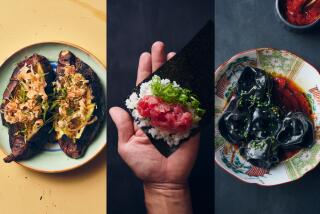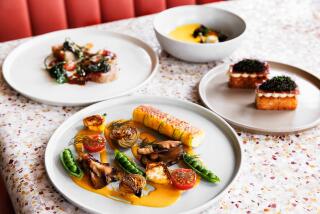THE FUNDAMENTALS OF WINTER COMFORTING
- Share via
The Swiss Restaurant, Hillside Village, 24594 Hawthorne Blvd., Torrance, 278-2686. Open for lunch Monday-Saturday and for brunch on Sunday. Dinner nightly, 5 to 9 p.m. (Friday-Saturday to 11 p.m.; early dinners Monday-Thursday, 4:30 to 6:30 p.m.). All major credit cards accepted. Parking lot. Dinner for two: $25 to $55 (food only).
Winter is gastronomy’s sentimental season. The rest of the year has its more capricious pleasures--the first asparagus of spring, the berries of summer and, in autumn--now that we know--the fresh porcini from Italy.
But, in winter, we want the comfort of the familiar when we come in from the cold--even from the lesser cold of Southern California. We want to be wrapped in blankets, hugged and put by the fire with hot chocolate, or creamed tomato soup, or polenta, or whatever once warmed our hearts and our stomachs.
Winter is no time for warm duck salad. It is a time for pot roast, cassoulet, squash and noodles and bollito misto.
Or a smooth and fragrant cheese fondue. Georges and Valerie Tribelhorn have recently added the Swiss Restaurant next door to their Marengo. One must believe that, in Switzerland, they understand the fundamentals of winter comforting.
The German, Swiss and French, each with its own part of Switzerland, have not exactly reconciled their different styles of cooking, but they exercise a sort of moral influence on each other.
“We have pasta and polenta,” said Georges Tribelhorn. “And we have Spaetzle--but we call it chnopfli, with an umlaut. And, as everyone, we learn from the French.”
Tribelhorn came from Zurich, which is German, spent his vacations with the Italians and his military service with the French. “So, I am acquainted with them all.”
He was graduated from the hotel school of Lausanne, worked in Switzerland, at various Hiltons in charge of food and beverage, and opened Marengo 10 years ago with his wife, Valerie.
There are some fairly formidable names on the menu--and some remarkably American--but among them are surprising delicacies. Chas chuechli is a small, delicate tart, crisply crusted, rich with cream and two cheeses. Bundnerfleisch is thinly sliced, air-dried beef, twirled in ribbons over greens sparked with cornichons and pickled pearl onions. A splendid dish with mustard and good dark bread.
A Schnitzel of pork arrived with discouraging bounties of chnopfli, warm red cabbage and dull green spinach. But the cabbage added a needed sweet zest to the pork--tender and tasty in itself--and the spinach belied its appearance with an engaging, creamy mellowness of flavor.
Tribelhorn has solved the problem of raclette in a thoroughly modern restaurant. Traditionally, the special cheese is held to a wood fire. As it begins to melt, the softened end is scraped over a boiled potato, and some patient soul puts it to the fire again for the next potato. Charming, but not exactly efficient. At the Swiss Restaurant, it is served in sufficiently melted slices with the potatoes, those peeled and thick-sliced to a thoroughly satisfactory result.
Cheese fondue also presents problems for a restaurant, and most efforts around town have been pretty dismal. “It is a matter of using the right cheese,” said Tribelhorn. “Cheeses from Switzerland perform differently.” It is served for two or more, a smooth blend of Emmenthal, Gruyere, wine and Kirsch that is entirely admirable--as fine as any I have had since a Swiss gentleman of my acquaintance presided over the delicate ritual in my own kitchen.
On one rainy day, I had kaseschnitten for lunch, heartiness for the weather. It is an open-faced sandwich, the bread dipped in white wine, sauteed in butter with ham and cheese, topped with a fried egg.
Tribelhorn says none of the desserts are really Swiss. But there is a hot apple crisp with ice cream that must come close--a rich concoction of raisins, apples, nuts and cinnamon. I thought it splendid. I also liked the Black Forest cake, with cherries tasting as though they had been fresh-picked that morning. And the cappuccino is great.
Pleased with the Swiss Restaurant, we returned to Marengo to find it mellowed and under control (reservations: 378-1174).
The original Napoleonic theme has been muted, although there is still the suggestion of the imperial tent. Poulet Marengo is still on the menu--not one of my best-loved dishes. The regular listing is fairly standard; specialties are more interesting. They are recited, I am sorry to say--but nicely recited.
Mussels, cultivated in Maine, were excellent in a light garlic and cream sauce (Belon oysters from Maine are also superior). Salmon was fresh and good in a deft cream and caper sauce, touched with mustard and scallions. (Salmon baloise , with a melted onion sauce, is also worth trying.) Lamb came tender and rare--albeit a little cool--in a good, simple reduction. Potatoes were oven-browned--Tribelhorn does not much like American potatoes; “too watery”--and turnips were also sliced and browned. Tarts--apple and pear--were adequate.
There is a sensible selection of wines, sensibly priced. Music, some nights, at both restaurants.
Does Tribelhorn do any of the cooking? “No. I do all the buying. I read cookbooks as though they were mysteries. But I like the overall supervision. The orchestration.”
More to Read
Eat your way across L.A.
Get our weekly Tasting Notes newsletter for reviews, news and more.
You may occasionally receive promotional content from the Los Angeles Times.






